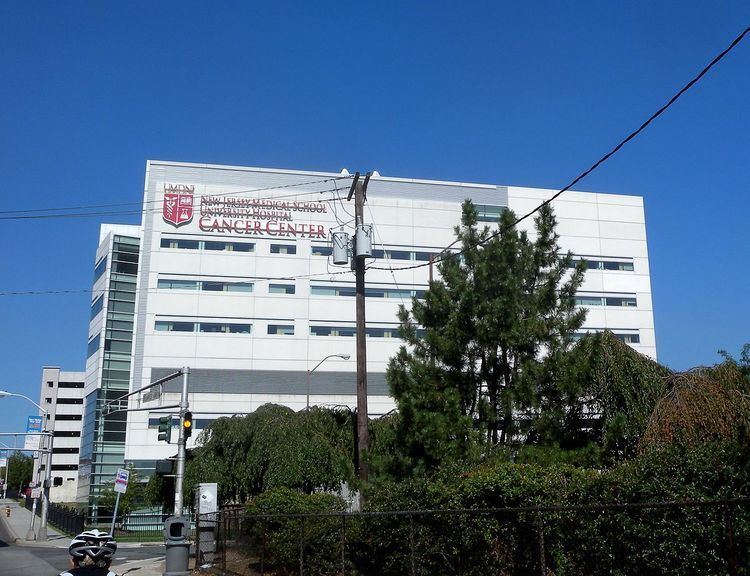Endowment $183 million Academic staff 2,391 | Active 1970–2013 President Denise V. Rodgers, MD Phone +1 973-972-4300 | |
 | ||
Undergraduate tuition and fees Local tuition: 10,208 USD (2011), Domestic tuition: 15,312 USD (2011) Notable alumni Jane Aronson, Param Gill, Steven Flanagan Similar Robert Wood Johnson, New Jersey Medical S, Rutgers University, Rutgers University–New Brunswick, Rutgers University–Newark | ||
The University of Medicine and Dentistry of New Jersey (UMDNJ) was a state-run health sciences institution of New Jersey, United States.
Contents
- University of medicine and dentistry of new jersey ems rescue 1 responding to an mva in newark
- History
- Academics
- Notable alumni and faculty
- Controversy and scandals
- References
It was founded as the Seton Hall College of Medicine and Dentistry in 1954, and by the 1980s was both a major school of health sciences, and a major research university. On July 1, 2013 it was dissolved, with most of its schools merging with Rutgers University to form a new Rutgers School of Biomedical and Health Sciences.
The School of Osteopathic Medicine however, along with its Graduate School of Biomedical Sciences, became part of Rowan University and was renamed the Rowan University School of Osteopathic Medicine.
University of medicine and dentistry of new jersey ems rescue 1 responding to an mva in newark
History
The Seton Hall College of Medicine and Dentistry was incorporated on August 6, 1954. The college enrolled its first class in 1956 at the Jersey City Medical Center. This was the forerunner of the New Jersey Medical School, the New Jersey Dental School, and the Graduate School of Biomedical Sciences. In 1965, the college was acquired by the state of New Jersey and renamed the New Jersey College of Medicine and Dentistry (NJCMD). Meanwhile, The Rutgers Medical School opened in 1966 as a two-year basic science institution offering the master of medical science (M.M.S.) degree. The College of Medicine and Dentistry of New Jersey (CMDNJ) was created by legislature in 1970 with the consolidation of the boards of trustees of Rutgers Medical School (now Robert Wood Johnson Medical School) and New Jersey College of Medicine and Dentistry. In 1981, the CMDNJ was renamed to the University of Medicine and Dentistry of New Jersey. It was the largest school of health sciences of its kind in the United States. It was also the leading research university in New Jersey, edging the other major research universities in the state (including Princeton University and Rutgers University) in federal research grant dollars. It did, however, have various academic partnerships with universities and other institutions in New Jersey.
Academics
UMDNJ was made up of 8 schools:
UMDNJ also operated The University Hospital in Newark, while Robert Wood Johnson University Hospital in New Brunswick, Hackensack University Medical Center in Hackensack and Cooper University Hospital in Camden were affiliates of UMDNJ. UMDNJ also operated a palliative care facility for people living with AIDS.
UMDNJ had approximately 7,000 students in more than 100 degree and certificate programs; more than 13,000 employees, including nearly 2,500 faculty members; more than 31,000 alumni and more than 200 education and healthcare affiliates throughout New Jersey. The University was dedicated to pursuing excellence in the education of health professionals and scientists, conducting research, delivering healthcare, and serving the community. The National Science Foundation ranked UMDNJ #71 out of 630 universities and colleges in terms of R&D expenditures.
Notable alumni and faculty
Controversy and scandals
UMDNJ was involved in a series of blunders that include Medicaid over-billings. The criminal complaint filed against the institution charged that health-care fraud occurred through alleged double-billing of Medicaid between May 2001 and November 2004 for physician services in outpatient clinics. A deferred prosecution agreement was filed in federal court in Newark, N.J., Dec. 29, 2005 to avoid prosecution. Herbert Jay Stern, a former U.S. Attorney and federal judge in New Jersey, was appointed as a federal monitor to oversee and enforce compliance in accordance with the deferred prosecution agreement that outlines reform and action to help resolve illegal practices and restore financial integrity and professionalism to the institution. In March 2008, UMDNJ announced that its accreditation by the Middle States Commission on Higher Education had been restored, following the termination of the Deferred Prosecution Agreement; Stern had recommended the return of full responsibility for governance of the institution to the UMDNJ Board of Trustees after implementation of a number of systemic reforms by the Board and administration.
In Stratford, New Jersey, at the UMDNJ School of Osteopathic Medicine, Warren Wallace, the prior Senior Associate Dean for Academic and Student Affairs, was terminated amid accusations of unethical behavior. Accusations include inappropriate use of UMDNJ time and resources for political activities, efforts to obtain no-bid contracts for a friend or neighbor, and inappropriate actions in relation to obtaining admission to the School of Osteopathic Medicine for his daughter.
UMDNJ had placed New Jersey Senator Wayne Bryant on a "no-show" job to increase funding for the school, Bryant being the chairman of the Senate Budget and Appropriations Committee and the Legislature's Joint Budget Oversight Committee. Bryant stepped down from this position in February 2007. The case was investigated by former United States Attorney (later New Jersey governor) Christopher Christie. Bryant was found guilty of the charges on November 19, 2008 and received a four-year sentence in federal prison. R. Michael Gallagher, former dean of the School of Osteopathic Medicine, was convicted of bribing Bryant and received an 18-month sentence.
